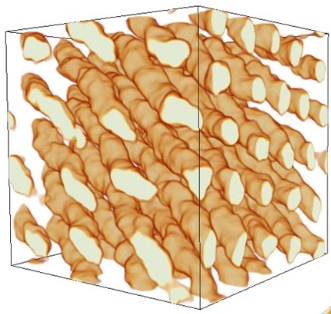
In this visualization from a molecular dynamics simulation (courtesy M. Caplan) we see how nuclei in the dense inner crust of a neutron star deform into non-spherical shapes. Here they form long thin rods—“spaghetti”.
Cooling Nuclear Pasta in Accreting Neutron Stars
Neutron stars are the densest objects in the observable universe. Many have a solar-like companion, from which they strip off hydrogen and helium. This gas then accretes onto the neutron star. Remarkably, astronomers have discovered that in some of these systems the accretion is intermittent: the neutron star accretes for months to a few years and heats up; the accretion then halts and the neutron star cools.
These cooling neutron stars provide a unique opportunity to probe the properties of matter at nuclear density. It has been long predicted that nuclei may deform at high densities from being roughly spherical to being rod- or plate-shaped. This phase of matter has been dubbed “nuclear pasta” (see Figure), with a forkful weighing 100 million tons.
A project led by MSU astronomy graduate student Alex Deibel has modeled the cooling of the neutron star MXB 1659-29 to investigate the effect of nuclear pasta on the long-term cooling of this source. This neutron star had been accreting gas from a companion star for about 2.5 years before accretion halted. Since then, the neutron star has been steadily cooling for over 10 years. The surface temperature of the neutron star has been monitored over this time by the X-ray satellites Chandra and XMM-Newton. Recent observations show that cooling may have slowed about 1000 days after accretion halted. This is consistent with an insulating layer deep in the crust. Recent simulations1 of nuclear pasta suggest the presence of structural defects in the pasta that inhibits its ability to conduct heat.
Although not conclusive, the observations have motivated further work to see if signatures of this pasta phase could be detected from other accreting neutron stars, as well as from cooling after flares from isolated, strongly magnetized, neutron stars.
- Caplan and Horowitz (2016), arXiv: 1606.03646